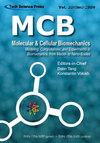多模态基于图像的心血管疾病建模方法:模拟、评估、预测和虚拟手术
Q4 Biochemistry, Genetics and Molecular Biology
引用次数: 2
摘要
近年来,医学成像和基于图像的建模在心血管研究中取得了相当大的进展,例如识别动脉粥样硬化斑块形态学和力学危险因素,可用于制定改进的患者筛查策略,以及进行虚拟心脏手术以寻求最佳手术方式以获得最佳术后结果。我们将报告使用多模态图像模型预测易损斑块进展和易损变化的最新进展。特别是,我们将报告我们最近使用IVUS+OCT数据的结果,以获得更准确的应力/应变计算。炎症和瓶盖侵蚀会影响瓶盖材料的性能。如果OCT图像可以提供炎症和侵蚀信息,帽应力/应变计算可以进一步改进。将介绍分子成像的初步结果。构建患者特异性心室模型,对修复性法洛四联症(TOF)患者进行虚拟手术,以预测术后预后,并寻找可用于识别可从肺动脉瓣置换术中获益更多的患者的参数。心脏磁共振(CMR)数据来自16名TOF患者(8名男性,中位年龄42.75岁)和6名健康组(HG)志愿者(1名男性,中位年龄20.1岁)。构建基于cmr的患者特异性计算RV/LV模型,获得RV壁厚(WT)、体积、曲率、机械应力和应变进行对比分析。我们发现机械应力可以很好地预测手术结果。致谢:本研究得到了NIH资助项目R01 EB004759, R01 h089269, NSF-China资助项目11672001,81571691,江苏省科技厅资助项目BE2016785的部分支持。关键词:心血管疾病,心室模型,易损斑块本文章由计算机程序翻译,如有差异,请以英文原文为准。
Multi-Modality Image-Based Modeling Approach for Cardiovascular Disease: Simulation, Assessment, Prediction, and Virtual Surgery
Medical imaging and image-based modeling have made considerable progress in recent years in cardiovascular research, such as identifying atherosclerotic plaque morphological and mechanical risk factors which may be used in developing improved patient screening strategies, and performing virtual heart surgery seeking optimal surgical procedures for best post-surgical outcome. We will report recent progress in using multi-modality image-based models to predict vulnerable plaque progression and vulnerability change. In particular, we will report our recent results using IVUS+OCT data to obtain more accurate stress/strain calculations. Inflammation and cap erosion will affect cap material properties. If OCT image could provide inflammation and erosion information, cap stress/strain calculation can be further improved. Preliminary results using molecular imaging will be presented.
Patient-specific ventricle models were constructed to perform virtual surgery for patients with repaired tetralogy of Fallot (TOF) to predict post-surgery outcome, and to seek parameters which could be used to identify patients who could benefit more from pulmonary valve replacement surgery. Cardiac magnetic resonance (CMR) data were obtained from 16 TOF patients (8 male, median age, 42.75) and 6 healthy group (HG) volunteers (1 male, median age, 20.1). CMR-based patient-specific computational RV/LV models were constructed to obtain RV wall thickness (WT), volumes, curvature, and mechanical stress and strain for comparative analysis. It was found that mechanical stress could be a good predictor for surgical outcome.
Acknowledgement: This research was supported in part by NIH grants R01 EB004759, R01 HL089269, NSF-China grants 11672001, 81571691, and a Jiangsu Province Science and Technology Agency grant BE2016785.
Keywords: Cardiovascular disease, ventricle model, vulnerable plaque.
求助全文
通过发布文献求助,成功后即可免费获取论文全文。
去求助
来源期刊

Molecular & Cellular Biomechanics
CELL BIOLOGYENGINEERING, BIOMEDICAL&-ENGINEERING, BIOMEDICAL
CiteScore
1.70
自引率
0.00%
发文量
21
期刊介绍:
The field of biomechanics concerns with motion, deformation, and forces in biological systems. With the explosive progress in molecular biology, genomic engineering, bioimaging, and nanotechnology, there will be an ever-increasing generation of knowledge and information concerning the mechanobiology of genes, proteins, cells, tissues, and organs. Such information will bring new diagnostic tools, new therapeutic approaches, and new knowledge on ourselves and our interactions with our environment. It becomes apparent that biomechanics focusing on molecules, cells as well as tissues and organs is an important aspect of modern biomedical sciences. The aims of this journal are to facilitate the studies of the mechanics of biomolecules (including proteins, genes, cytoskeletons, etc.), cells (and their interactions with extracellular matrix), tissues and organs, the development of relevant advanced mathematical methods, and the discovery of biological secrets. As science concerns only with relative truth, we seek ideas that are state-of-the-art, which may be controversial, but stimulate and promote new ideas, new techniques, and new applications.
 求助内容:
求助内容: 应助结果提醒方式:
应助结果提醒方式:


